skip to main |
skip to sidebar
Events of Tuesday, 24th April 2018
After a pleasant breakfast at the hotel, the charming man from Care Myanmar picked us up to take us to the distribution at Hlaing Drop In Centre. With almost 400 children attending this distribution, there is insufficient room for them inside the Drop In Centre itself so, in previous years, collapsible sun shelters have been erected in the field adjacent to the D.I.C. building. But, in 2018, the shelters had been erected on the narrow concrete road outside the D.I.C., leaving a narrow space at one side to allow pedestrians and motor cycles passage. The expectant children were quietly waiting on groundsheets laid under the shelters which were topped with green woven plastic sheeting as a sun screen. I was amused to note that, to prevent the sheeting from sagging, a number of 'U'-shaped lengths of rebar (steel reinforcing bar) had been laid across the framework. Staff and volunteers were busy distributing snacks to the children.
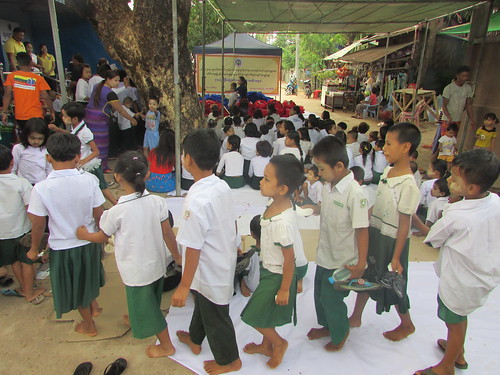
Distribution at Hlaing D.I.C.
There were a number of Outstanding Students who were presented with a modest extra reward of stationery by way of encouragement.
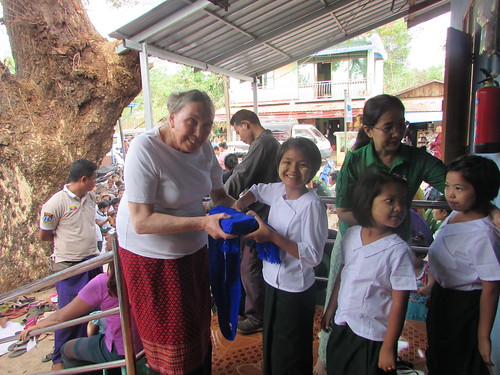
Distribution to Outstanding Students at Hlaing D.I.C.
We then moved outside for the main presentations. A 'stage' had been built at the front, filled with shoulder bags containing the items being distributed. Each distribution comprised school uniform, exercise books, pencils or pens placed in a colourful shoulder bag. However, the exact contents depended upon age and sex of the recipient. The uniforms differ between boys and girls and differ with age (primary school boys start with short trousers but then move to the male version of the longyi). Primary school children only use pencils but older pupils use ballpoint pens.
A sound system with a radio microphone had been provided but did not seem to be working correctly so we switched to a battery-operated bullhorn. The Doctor invited me to give a short address so, using the bullhorn, I delivered my homily on the importance of education (in short sections, pausing to let the Doctor translate before continuing).
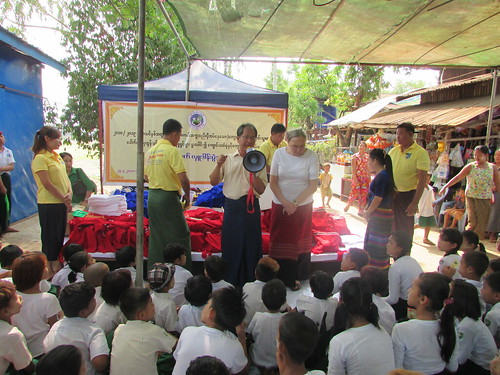
Distribution at Hlaing D.I.C. - the Doctor translates Jan's address.
Next, we had the actual distribution. Volunteers were on hand firstly to check the 'admission ticket' of each child, then to ensure that the Doctor and I placed the correct type of shoulder bag over the student's head. Where children were still clutching the snacks they'd been given, we tried to add them to the shoulder bag to prevent loss. Each child was then allowed to select a lottery ticket which they then examined to look for the all-important 'tick' which indicated that they'd won a towel. In a few rather hectic minutes, we'd handed out most of the 386 bags.
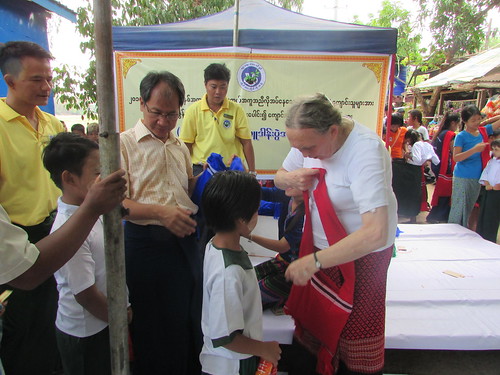
Distribution at Hlaing D.I.C.
There was then a much quicker presentation of towels to the winners. Because the staff had been included in the lottery, a few of the towels went to delighted staff.
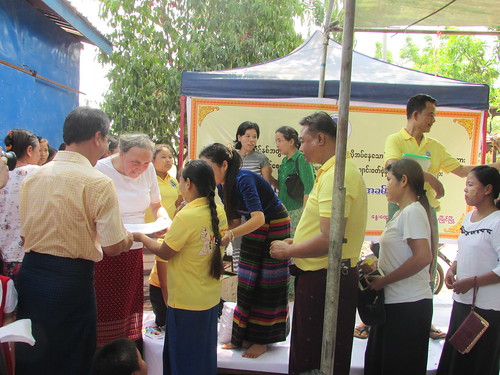
Distribution at Hlaing D.I.C. - lottery winners receive White Towels.
As the children left, all the staff assembled on the steps of the D.I.C. for the staff group picture.
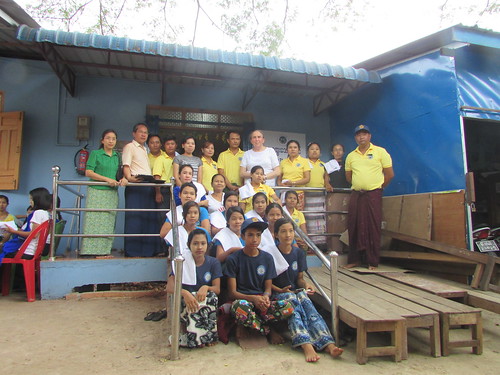
Distribution at Hlaing D.I.C. - Staff and volunteers
We then moved inside the D.I.C. where a group of mainly elderly local residents had assembled for the selection of reading glasses from a collection which had been donated. This wasn't a very scientific process - the local people simply picked a pair whose style they liked which improved their ability to read one of a number of newspapers provided.
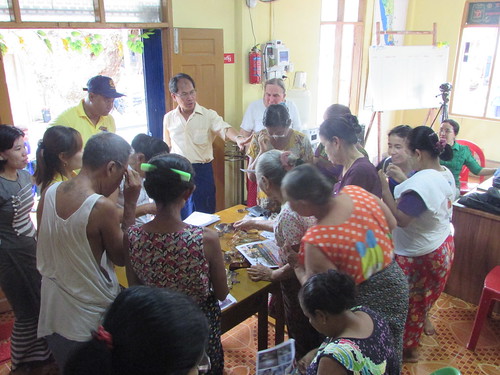
Distribution at Hlaing D.I.C. - selection of reading glasses
By this time, the 'stage' (actually a series of long benches) had been dismantled and loaded onto a motor cycle taxi which was just setting off the return them, probably to a school.
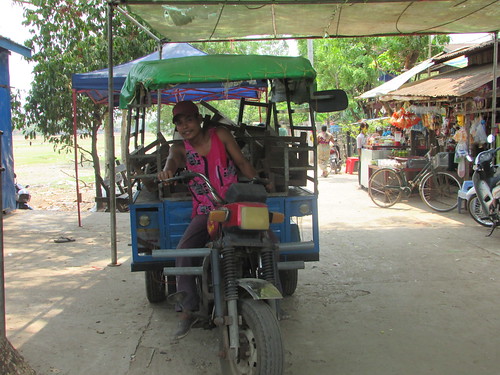 Distribution at Hlaing D.I.C. - a motor cycle taxi removes the 'stage'
Distribution at Hlaing D.I.C. - a motor cycle taxi removes the 'stage'
Hlaing is a very poor area and there are a number of noted 'Poor Houses' where elderly and disabled people eke out a subsistence with the help of charity from local people. We visited a number of very basic bamboo shacks where the Doctor and I made donations of clothing and money. There is no Social Care 'safety net' in Myanmar.
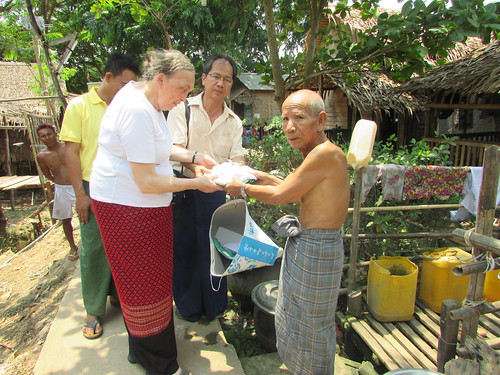
Visiting 'Poor Houses' in Hlaing District of Mawlamyine
We were then driven to our hotel to check-out before moving on to the Care Myanmar offices. The staff kindly placed a sleeping mat and pillow on the office floor so that I could lie down for a while and that revived me.
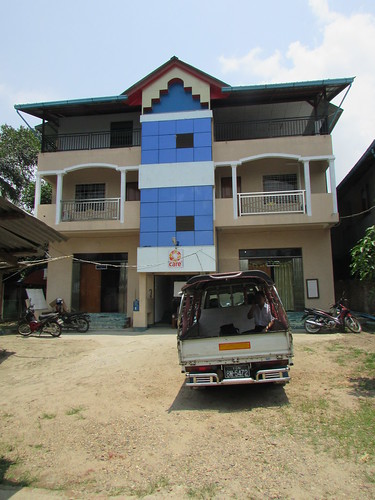
Care Myanmar Offices, Mawlamyine
Our last distribution was at the 'Future Generation' Drop in Centre in another part of Mawlamyine.
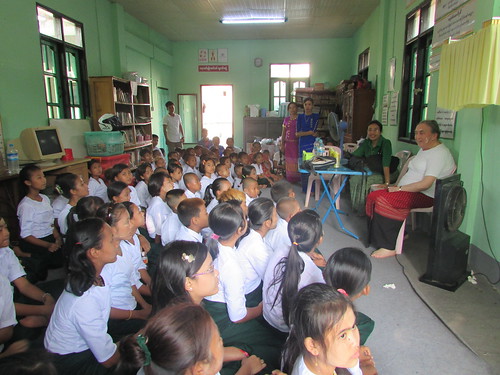
Distribution at 'Future Generation' D.I.C.
Again, the staff and most of the children were unchanged since the previous year. I gave a short address, translated by the Doctor then we made a few presentations to outstanding students. The lottery for towels followed, as always causing great amusement.
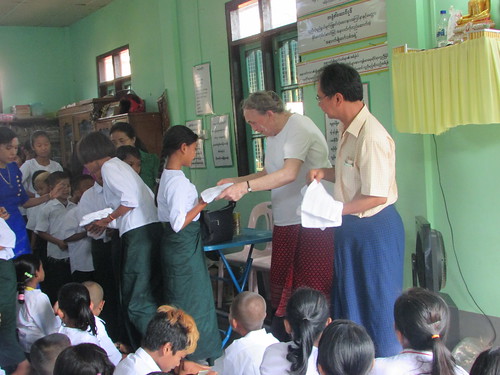
Distribution of White Towels at 'Future Generation' D.I.C.
At this D.I.C., the distributions had been packed in plastic bags, so I generally only had to present the bag to each student.
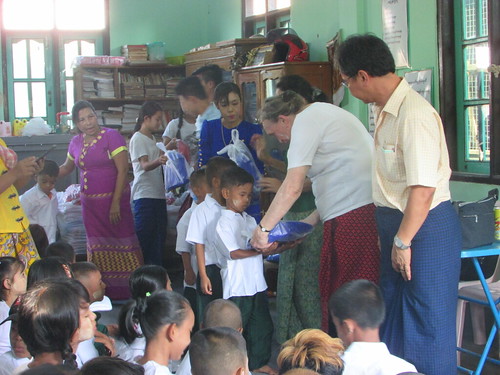
Distribution at 'Future Generation' D.I.C.
The students then changed into their new uniforms for a series of 'Group Shots', taken in the street outside, lit by the late afternoon sun. As always, it was a very jolly affair.
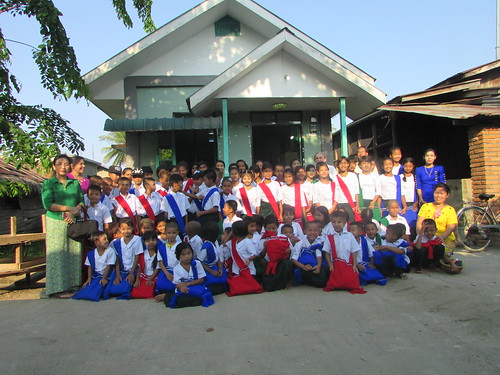
Distribution at 'Future Generation' D.I.C. - the Group Shot
We enjoyed dinner at a tea-shop with two of the local staff.
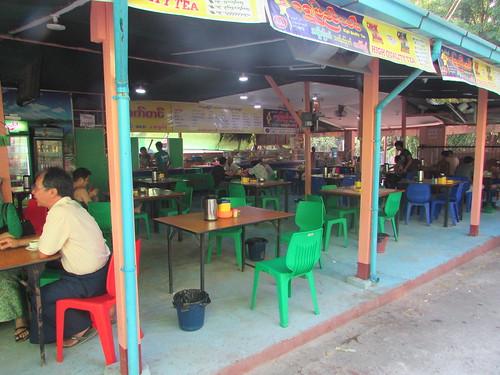
Evening meal in Mawlamyine
There was then just time to pay respects at the Kyaik Thote Pagoda in Mawlamyine before heading to the Bus Terminal to catch the 9.0 p.m. bus to Yangon. With one stop for toilets and refreshments, we were back at Yangon's Eastern Long Distance Bus Terminal by about 3.30 a.m. on Wednesday. A taxi took us to the Doctor's house in less than half an hour. Despite having slept well on the bus, I happily slept for a few more hours at the Doctor's house after a wonderful but very tiring few days in Mon State.
Total Distributions in Mon State 2018
| Drop in Centre |
Number |
| Ko Dut (total) |
341 |
| Mudon (total) |
191 |
| Hlaing |
386 |
| Future Generation |
130 |
| Total |
1048 |
Related posts on this website
This is one of a series of posts describing my 13th visit to Myanmar. The post Travelling again is the first post in the series.
Clicking on the 'Next report' link will show the post describing the next events. In this way, you may read about the trip in sequence.
Next post.
Alternately, clicking on the 'All my Burma-2018 reports' link displays all the posts on this trip in reverse date-of-posting order.
All my Burma-2018 reports.
My pictures
Distribution at Hlaing D.I.C.
Distribution at 'Better Futures' D.I.C.
Kaung Myat Hotel, Mawlamyine (2017 pictures)
Care Myanmar Offices, Mawlamyine (2017 pictures)
All my pictures on this trip to Myanmar can be found at Burma 2018.
[Pictures linked 10-May-2018: Pictures inserted 28-May-2018: Naming corrected 25-Feb-2019]
Events of Monday, 23nd April 2018
After our second night sleeping at the Drop In Centre, we said 'Goodbye' to our friends at Ko Dut. There was time for a final 'group photo' with the staff present before we set off by taxi.
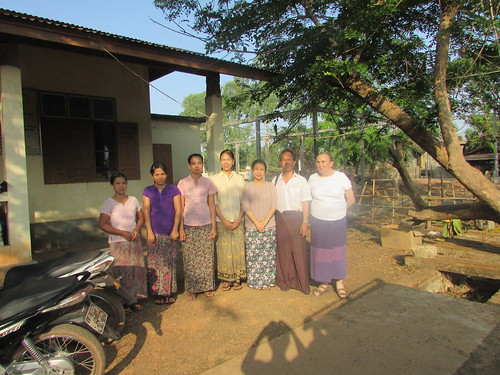
Ko Dut D.I.C. - leaving on 23rd April 2018
Our first destination was Khaikhami Yele Paya Pagoda, built over the sea. I've visited this important shrine a number of times, mentioning my last and earlier visits in the post here.
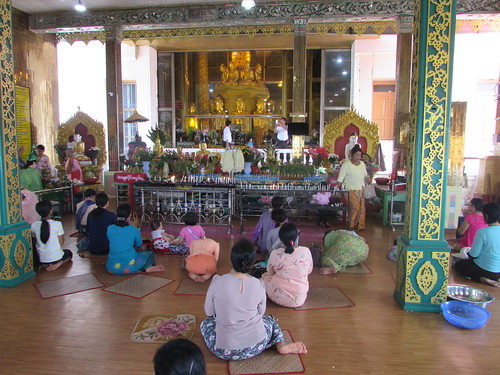
Khaikhami Yele Paya Pagoda
Our first distribution was at the Drop In Centre at Ka Mar Wet. I'm afraid in earlier reports, I may have confused some of the names but I hope I have it correct this year. Some of these places are quite difficult to find unless you are local. As arranged by mobile phone, we were met on the main road by a man on a motor cycle in a silver crash helmet who conducted us through the narrow streets to the D.I.C.
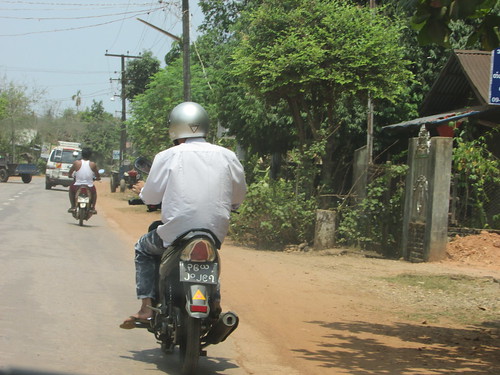
Our motor cycle guide conducting us to Ka Mar Wet D.I.C.
I may confuse the names, but not the people and warm greetings were exchanged. I can't claim to remember each child but some are firm in my memory. When the Doctor enquired, the majority of the children remembered our last visit - long-term commitment to this type of programme is essential. Once again, the Doctor held a lottery to determine who received one of the limited number of white towels. I admit to initially having doubts about the lottery idea but these were dispelled by the sheer sense of fun created. I was pleased that the staff were included in the lottery and the winners from this group seemed even more excited than the children!
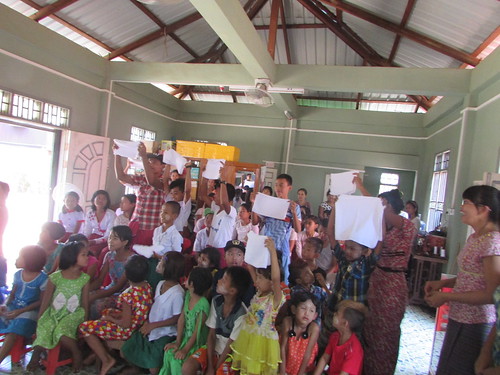
Ka Mar Wet D.I.C. - White towel winners proudly show their prize.
Then the distributions to all the children took place - a new school uniform and items of stationery.
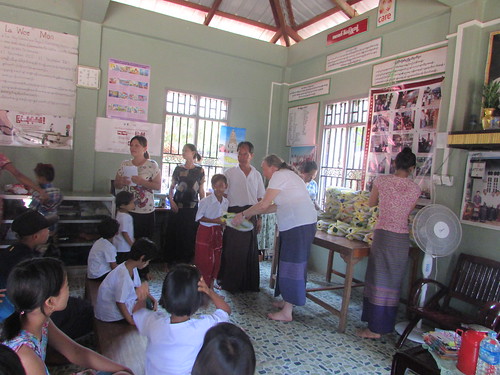
Ka Mar Wet D.I.C. - the distribution.
The children proudly donned their new uniforms so that photographs, including the 'group shot' outside the building, could be made to record the event.
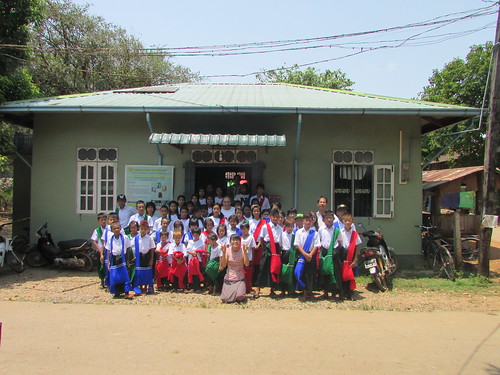
Ka Mar Wet D.I.C.
The children were then able to leave but, finally, the Doctor refunded certain other agreed expenses to the manager.
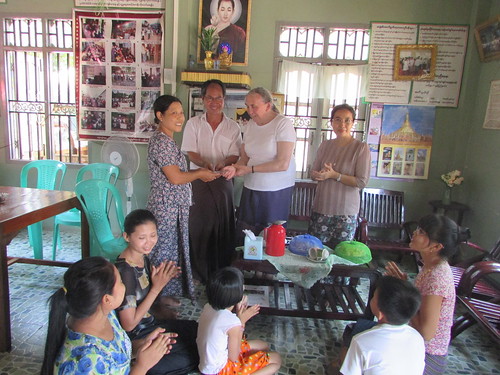
Ka Mar Wet D.I.C.
I was wearing the longyi they'd given me the previous year (described here) and, before we left, they presented me with another longyi in a beautiful Mon pattern.
Our motor cycle guide then conducted us to Mu Don Drop In Centre for our second distribution of the day. The journey concluded in a baffling series of narrow alleys barely suitable for a motor cycle, let alone a taxi. We started with a special presentation of stationery items to a number of Outstanding Students.
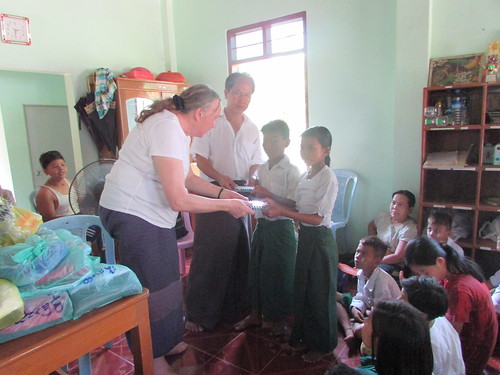
Distribution to Outstanding Students at Mu Don D.I.C.
Then, we conducted the lottery for the limited number of towels which created great amusement.
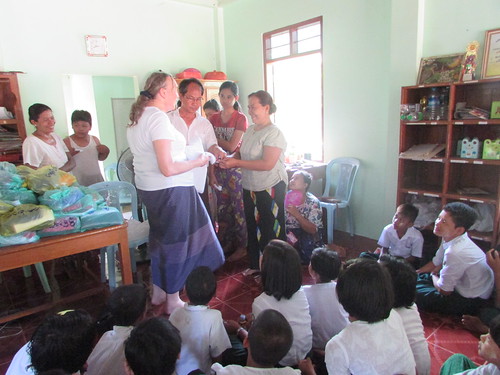
Distribution at Mu Don D.I.C.
Finally, the serious business of equipping each child with stationery and items for the forthcoming year. I was presented with a lovely decorated cotton blanket. Everybody then trooped out into the sun for photographs.
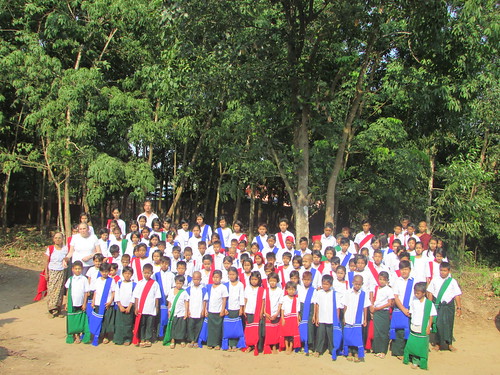
Distribution at Mu Don D.I.C. - The Group Photograph
I watched with interest as a group of children from one particular area departed in a covered pick-up with seats. With about eight children in the luggage rack on the roof, there must have been about 30 passengers!
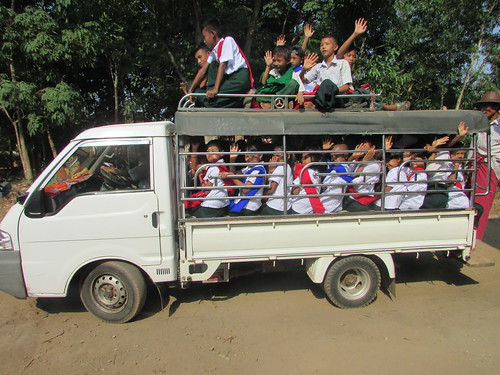
Happy students leaving the distribution at Mu Don D.I.C.
Once again, our guide conducted us to our final Drop In Centre of the day at Kot Kha Pon. By this time, the combination of the heat and an infection which the Doctor was treating had exhausted me, but I did the best I could. Instead of repeating the address to the children I'd been using on this trip (a rather Victorian-sounding tale extolling the virtues of education, hard work and being good to one another), the Doctor paraphrased its content for me.
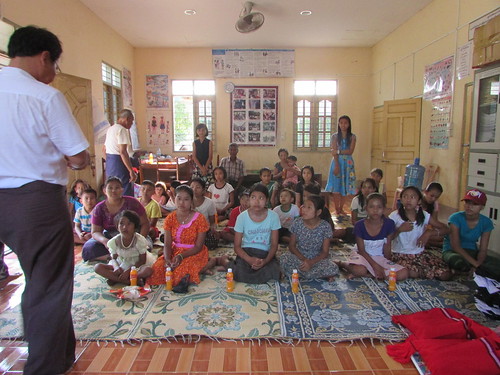 >br>
Dr. Hla Tun addresses the students at Kot Kha Pon D.I.C.
>br>
Dr. Hla Tun addresses the students at Kot Kha Pon D.I.C.
Three Outstanding Students received a special presentation of stationery, then we had the fun of the lottery for the presentation of towels and finally the distribution to all the children. With a smaller number of children at this location, we were able to take the group pictures inside the building. The staff kindly gave me a blanket in appreciation of the support for their work.
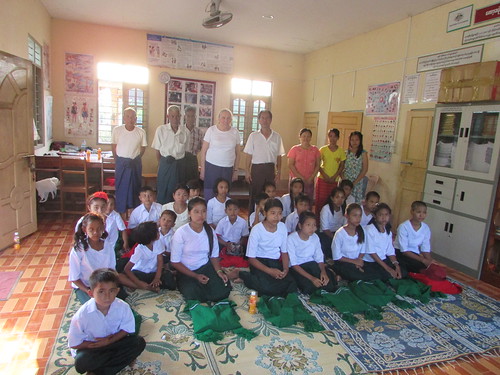
Distribution at Kot Kha Pon D.I.C.
The taxi then headed north on Route 8 for a little under 30 km to Mawlamyine, where the Doctor had booked rooms in the Kaung Myat Hotel.
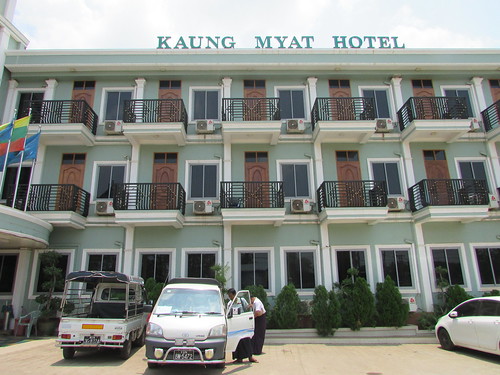
Kaung Myat Hotel, Mawlamyine
On arrival, I was happy to 'hole-up' in my room after a fairly strenuous day, with food and drink provided by the Doctor to keep me going. I backed up my pictures to the computer and found the hotel's Wi-Fi was working so I was able to receive a few e-mails and deal with them and convert a Word document I'd been working on into a blog post. The following day, we would be making distributions at two Drop In Centres in Mawlamyine.
Related posts on this website
This is one of a series of posts describing my 13th visit to Myanmar. The post Travelling again is the first post in the series.
Clicking on the 'Next report' link will show the post describing the next events. In this way, you may read about the trip in sequence.
Next report
Alternately, clicking on the 'All my Burma-2018 reports' link displays all the posts on this trip in reverse date-of-posting order.
All my Burma-2018 reports.
My pictures
Khaikhami Yele Paya Pagoda and Ka Mar Wet D.I.C.
Distribution at Mu Don D.I.C.
Distribution at Kot Kha Pon D.I.C.
All my pictures on this trip to Myanmar can be found at Burma 2018.
[Pictures linked 10-May-2018, Pictures inserted 27-May-2018]
Events of Sunday, 22nd April 2018
When I got up, there were already cattle quietly foraging for breakfast in the rubbish near the Drop In Centre.
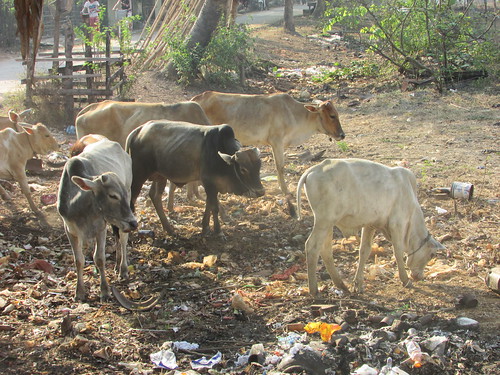
Ko Dut D.I.C.: Cattle foraging for breakfast.
We first went to the house and shop of one of the D.I.C. teachers, Shu Lwum, for breakfast.
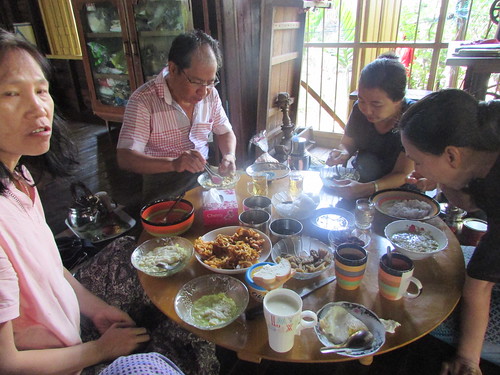
Ko Dut D.I.C.: Breakfast at Shophouse of Shu Lwum
The meal was accompanied by loud music from a couple of streets away which, when we left, I tracked down to a 'Wall of Sound' outside a private house (I talked about the 'Wall of Sound' in the earlier post here). The Doctor explained that the 'Wall of Sound' was part of the celebrations for a wedding and that the music helped guests unfamiliar with the area to locate the correct address. This installation comprised 10 base speakers, two exponential horns and a group of 'tweeters', all held together by a ratchet strap.
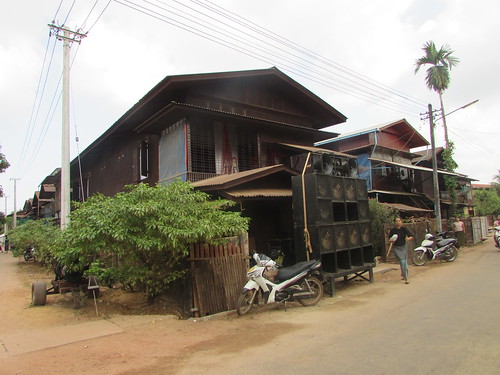
Ko Dut 2018: 'Wall of Sound' to celebrate wedding.
Back at the D.I.C., I was presented by the staff with a beautiful red and black longyi in a traditional Mon pattern which they insisted I put on straight away.
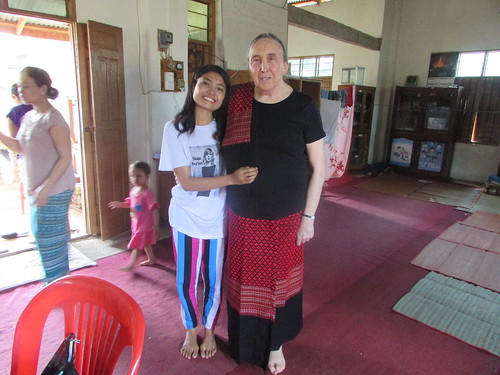
Ko Dut D.I.C.: Jan with new Longyi and the seamstress.
After the inevitable 'group shot' outside the D.I.C. there was a traditional, formal thanksgiving by the staff for the donations they had received.
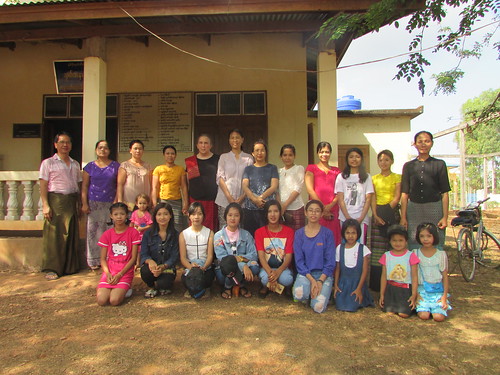
Ko Dut D.I.C. Volunteers and teachers.
Doctor Hla Tun has established a tradition of taking the staff and volunteers at Ko Dut Drop In Centre for a meal during his annual visit, as a way of saying 'Thank You' for their work throughout the year. This year, it was extended into a full day out. The Doctor, his wife, two staff from the Drop In Centre (the manager Yu Mon and teacher Shu Lwum) and the writer took a taxi, the others followed in a covered pick-up with seats. We headed south towards Ye Township (sometimed spelled as Yaye) to visit the extensive Ko Yin Lay ('Young Monk') pagoda.
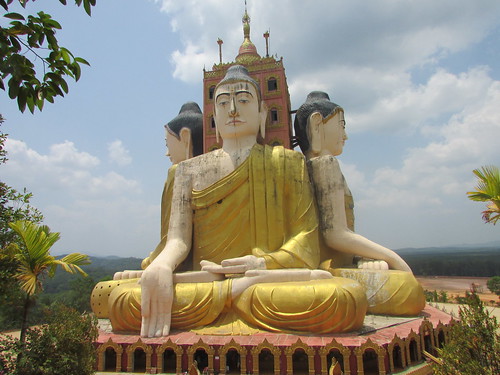
Ko Yin Lay Pagoda near Ye, Mon State, 2018
Here I was delighted to meet again the nun who had accompanied us on a visit the previous year. What I now discovered was that she is the sister of teacher Shu Lwum.
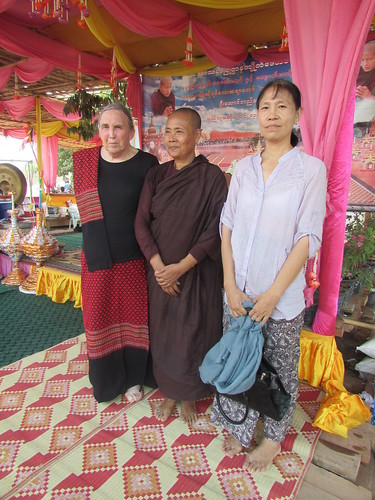
Ko Yin Lay Pagoda: Jan, the Nun and her sister Shu Lwum.
The latest project is a pagoda surrounded by hundreds of miniature pagodas, apparently in tribute to the Kuthodaw Paya in Mandalay (I described a visit to the Kuthodaw here).
Near Ye, we stopped at a roadside restaurant for lunch. Whilst we were there, a car apparently struck a motor cycle right outside the restaurant and a girl from the motor cycle, clearly shocked, sustained a cut ankle. Staff from the restaurant immediately seated her inside and bathed the ankle with water. Doctor Hla Tun provided adhesive plasters and antiseptic cream but otherwise was not required. Myanmar people accept this type of minor mishap with equanimity.
After an enjoyable meal, we continued to the beach at Ka Byar Wa. It was a very pretty bay with a safe, sandy beach popular with local people. Food was available, there was a row of steamer chairs shaded by large umbrellas for hire and inflated lorry inner tubes could be hired as flotation devices in the sea. There were a couple of inflatable boats on the beach fitted with outboard engines, but neither was in use.
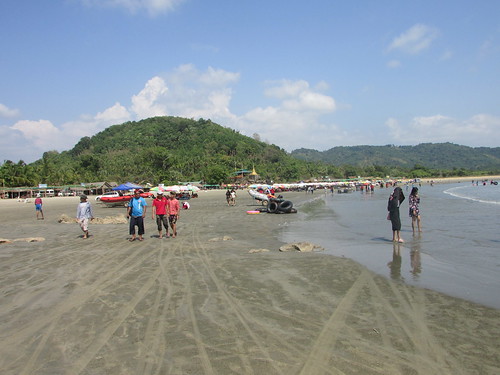
The beach at Ka Byar Wa
I watched with interest as two boys in a 2-man kayak attempted to 'surf' their boat on the incoming tide. The first time they did remarkably well but a number of subsequent attempts all ended in a capsize. After a pleasant interlude in the sun at the beach, we boarded the taxi and the pick-up truck.
I assumed we were returning to Ko Dut but, after heading north we turned off into the hills, travelling for some distance on very narrow roads carrying unexpectedly heavy traffic. We ended up in a car park in a field accessed by a very steep slope. It was all very puzzling for me until we left the taxi and walked to the improbable destination: a shallow river with lots of people, adults and children, bathing and swimming. The Doctor explained that the location, Chaung Gwa, had become a popular destination, particularly for parents with young children, because of the crystal-clear fresh water and safe bathing. The one river bank was very low and I assumed it would be subject to flooding at times. This bank, formed from flat, rounded stones formed the unlikely location for a extensive market.
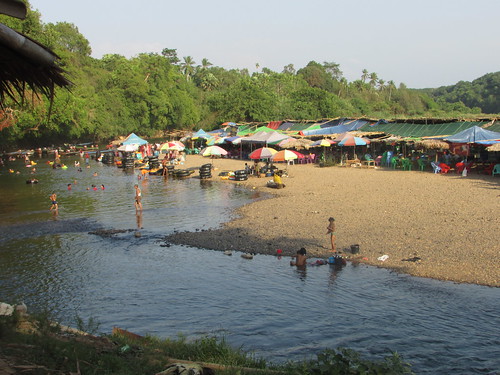
Chaung Gwa river bathing and market
Up river from the market, a number of long-tail boats were coming and going, man-hauled near the boarding place but starting their engines once clear. The Doctor explained that the boats provided a shuttle service to and from the nearby Chaung Gwa Pagoda and offered a visit, which I readily accepted, although I'd already seen boat passengers having to wade through the water across the stones to enter and leave the boats.
Well, with my European soft-soled feet and general tendency to wobble, I needed plenty of help from my friends to safely board the boat but the boat trip through the twisting river valley was wonderful.
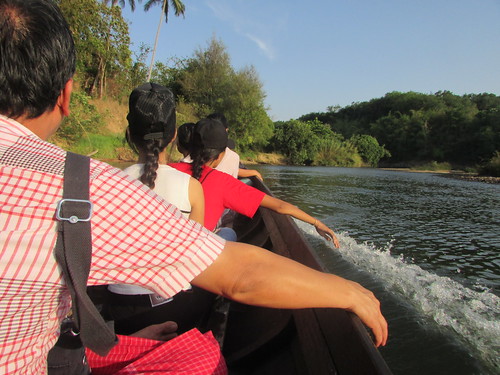
By long-tail boat up river to Chaung Gwa Pagoda
A final twist in the river revealed a surprisingly small pagoda perched on the hillside, with modern statues on an adjacent tall, square, painted concrete pillar set in the river.
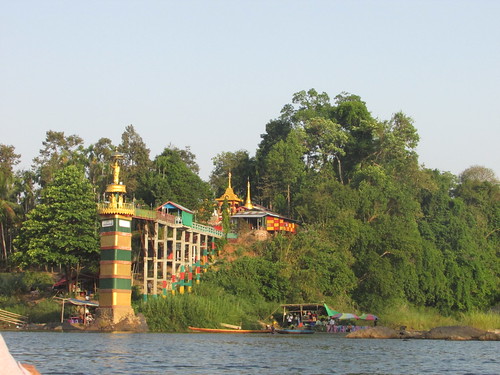
Chaung Gwa Pagoda, viewed from the river
On our arrival, leaving the boat proved a little easier than boarding, although it still involved wading through water over stones in bare feet. An uneven earth footpath then led to the base of a long, straight concrete staircase which led to the pagoda platform. At a slightly lower level, a horizontal walkway led across to the pillar with the statues, giving visitors commanding views downstream.
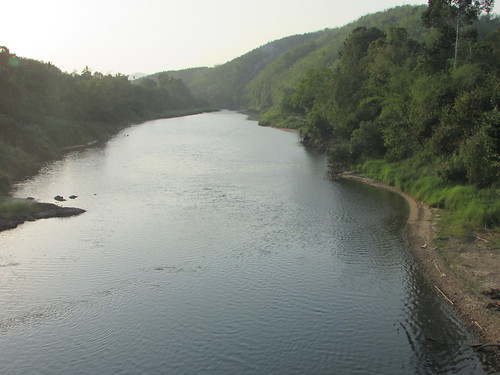 Chaung Gwa Pagoda: View looking downstream from the pagoda platform
Chaung Gwa Pagoda: View looking downstream from the pagoda platform
The return boat trip was equally enjoyable but, by this time, I was starting to fade and the walk back through the market (across the stones) to our taxi was tiring. This time, our destination really was Ko Dut. It was dark when we arrived but they started the petrol generator so we had light and I was able to charge my computer and camera before retiring for the night after a splendid day with my friends.
Related posts on this website
This is one of a series of posts describing my 13th visit to Myanmar. The post Travelling again is the first post in the series.
Clicking on the 'Next report' link will show the post describing the next events. In this way, you may read about the trip in sequence.
Next report
Alternately, clicking on the 'All my Burma-2018 reports' link displays all the posts on this trip in reverse date-of-posting order.
All my Burma-2018 reports.
My pictures
La Mine and Ko Dut D.I.C.
Ko Yin Lay Pagoda and the beach at Ka Byar Wa.
Chaung Gwa, Chaung Gwa Pagoda and back to Ko Dut.
All my pictures on this trip to Myanmar can be found at Burma 2018.
[Pictures linked 10-May-2018, Pictures inserted 26-May-2018]
Events of 20th October/Saturday 21st October
We left the doctor’s house by taxi about 7.15 pm with the Doctor, his wife and the writer as passengers, together with our luggage and two large bundles of small, white towels given by a donor. The towels were packed in tens in polythene bags which had been bundled in sacking, then stitched to make secure parcels. In common with most Yangon taxis, the luggage space was reduced by a large propane gas tank in the boot. It took about an hour to reach the Eastern Long Distance Bus Terminal, which was as chaotic as ever.
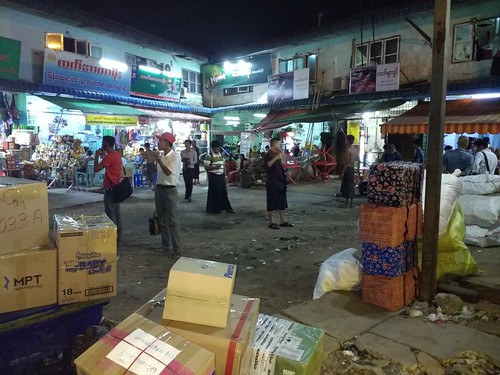
Eastern Long Distance Bus Terminal, Yangon: 21st April 2018.
Somehow, we got our own luggage into the commodious luggage hold but only after 7 men (5 runners, one unloader and one loader) had transferred the contents of a packed covered pick-up to the coach in an attempt to show the limits of the luggage space. The coach was a modern Chinese offering with left hand drive. The left hand drive was quite a relief in a country which now drives on the right (following a pronouncement by the notorious General Ne Win in 1970). Even when the legacy of right-hand drive vehicles for driving on the left had been replaced, the replacements were often from left-driving nations (most notably Japan), to the discomfort of nervous front seat passengers. Each side window of the coach was provided with heavily-swagged curtains giving, I thought, a curious 'Gipsy’ feel.
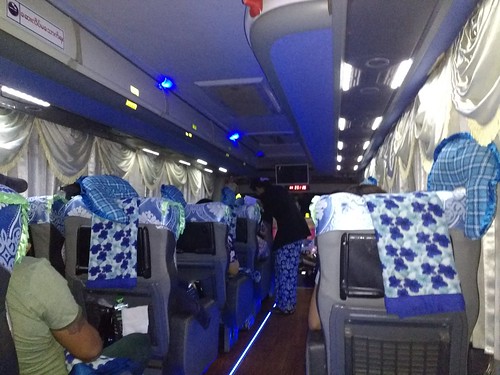
Our coach from Yangon: 21st April 2018.
We started our journey, around 9.15 p.m., travelling backwards. In common with many Myanmar bus stations, arriving buses head towards a long building divided into offices, waiting areas and maintenance bays for the various companies, meaning that departure involves reversing into a continuous flow of buses, taxis, pick-ups, motor cycles, push bikes and the variety of modified light carriers which inhabit these areas. After a series of starts, shouted warnings, urgent horns and fierce stops, the coach inserted itself into the melee and, now travelling forwards, after a few minutes we found ourselves on the main road where speed picked up giving a demonstration of just how hard the suspension was.
By midnight, we’d pulled up at one of the roadside cafes that service the long distance coaches. By western standards, most of the toilets at these places are rather primitive but, at the café areas, the staff perform prodigious tasks of providing fresh-cooked Myanmar food to a rapidly-changing clientele. Fast it may be but it does seem to involve an awful lot of shouting between staff. After a couple more hours on the road we made another refreshment stop where the toilet facilities were quite restricted. I’d assumed we’d leave the coach at Mawlamyine around one hour later, as we had previously, but I discovered we were travelling further on the coach. We didn’t stop long at Mawlamyine Bus Station but we stopped again on the outskirts of town whilst parcels were extracted from our luggage compartments and stuffed into a pickup truck which had appeared. Around 6.30 Saturday morning, the coach stopped again near a road junction in Mawkan, which I recognised as our drop off point the previous year when we headed north from Dawei in a minibus. The manager from Ko-Dut Drop In Centre was again waiting for us with a taxi. There was a slight delay because the parcels unloading on the outskirts of Mawlamyine had managed to thoroughly mix-up the remaining parcels and luggage but, after a frantic few minutes, we’d retrieved everything we’d started out with and were able to board the taxi and drive the last few miles to Ko Dut. When we arrived, there were plenty of staff but the building wasn’t besieged by children so I wasn’t surprised when the Doctor told me the distributions would be held in Ko Dut Monastery, as the previous year.
Although I’d managed some sleep on the journey, tiredness was starting to overtake me but a shower (Burmese style) revived me a little and the Doctor, his wife and I took breakfast together (oatmeal, fried egg, white bread and margarine and English Breakfast tea for me). All the young volunteers then had a ‘second sitting’ of breakfast, by which time the taxi had returned and it was time to load the sacks full of uniforms, towels and snacks for transfer to the monastery. The attractive red and blue traditional Burmese shoulder bags had previously been packed with the stationery being given to each child and the volunteers ferried these to the monastery using their own motor bicycles, the driver and one or two passengers each festooned with as many bags as they could manage.
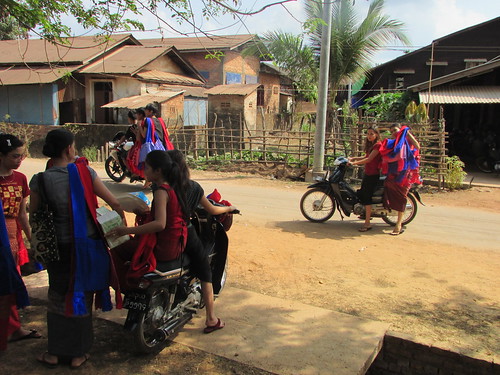
Distribution at Ko Dut Monastery, 2018: Volunteers ferrying school bags by motor cycle from the Drop In Centre to the Monastery.
Finally, the taxi returned to take the Doctor, his wife and the writer to the monastery. In the large assembly hall, there were separate groups of, mainly young, children from both Government schools and Mon Ethnic Schools who were to receive the distribution of stationery and a new school uniform.
As more children arrived, the individual groups were combined into two phalanxes, theatre-style but without the cbairs. Eventually, a senior monk from the monastery arrived accompanied by a young monk who, I was to discover, was an excellent English speaker. The monk encouraged the children to recite a clearly well-known prayer and afterwards he addressed them for a few minutes. Afterwards, the young monk translated the gist of the speech: the importance of education, remembering that it makes you clever, not necessarily good and the evils of drugs. Whilst not a Buddhist, I agreed with these sentiments. The monk also made gracious comments about foreign donors who make this type of distribution possible.

Distribution at Ko Dut Monastery, 2018.
The senior monk asked me to address the children and my brief English homily was translated into the Mon dialect by one of the teachers. The shoulder bags packed with stationery were then presented to each child.
There were insufficient white towels to allow each child to have one, so the Doctor instituted a lottery which added to the fun. Square lottery tickets had been cut from white paper and winning tickets were marked with a symbol. Each ticket was then tightly rolled. Another little ceremony presented the winners with their prize.
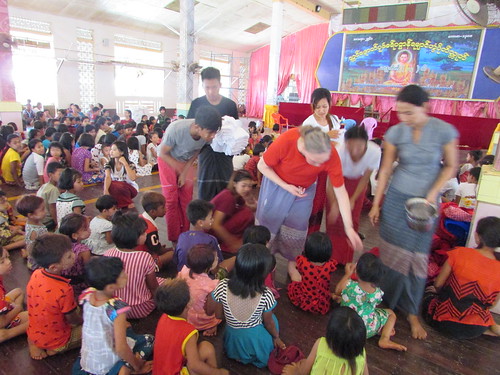
Distribution at Ko Dut Monastery, 2018: Jan helping to distribute lottery tickets for the limited number of white towels.
All the children then formed up on a large, concrete staircase for the traditional group photograph.
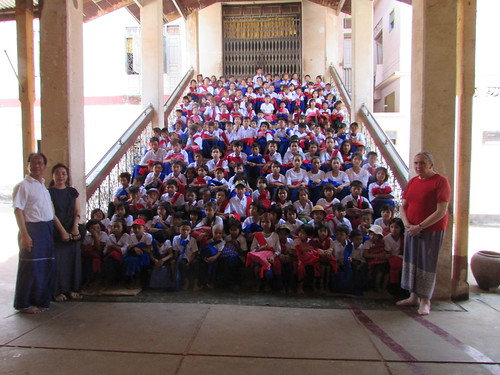
Distribution ar Ko Dut Monastery, 2018: the Group Photograph.
This format was repeated at our second visit of the day to the Drop In Centre at La Mine which is quite small but provides vital support to the youngsters. Most of the children remembered previous visits which I’d made and the teachers and volunteers were unchanged. The element of dependability can be so important in the lives of children lacking traditional family support.
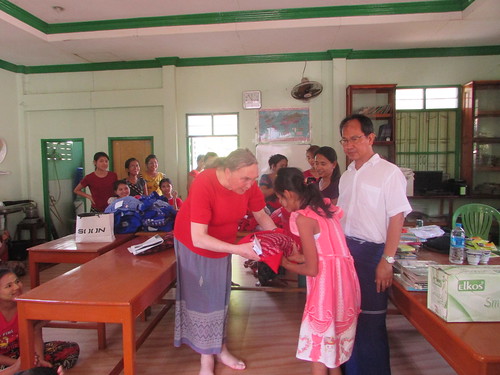
Distribution at La Mine Drop In Centre
The lottery for white towels followed: an Imaginative volunteer had decorated winning tickets with a 'smiley face'.

A winning ticket!
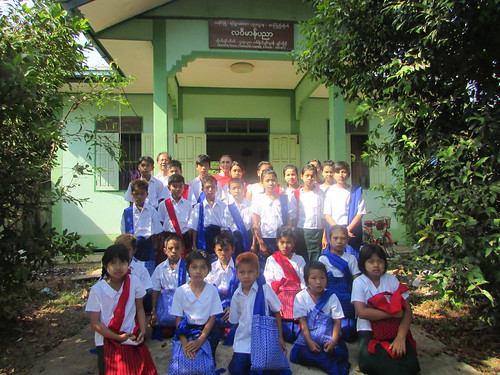
Distribution at La Mine Drop In Centre: the group photograph.
After the group photograph at La Mine, we drove to our final visit of the day, to another small Drop In Centre at Mot Ka Nin. Once again, staff and students were largely unchanged since my last visit about one year ago.
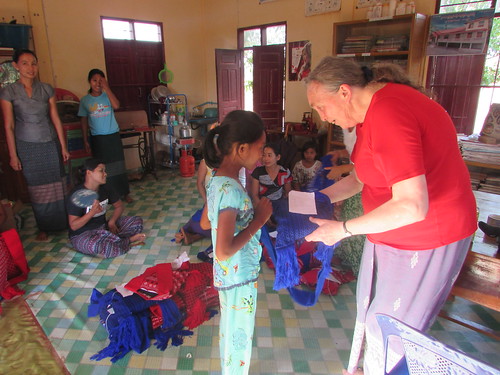
Distribution at Mot Ka Nin
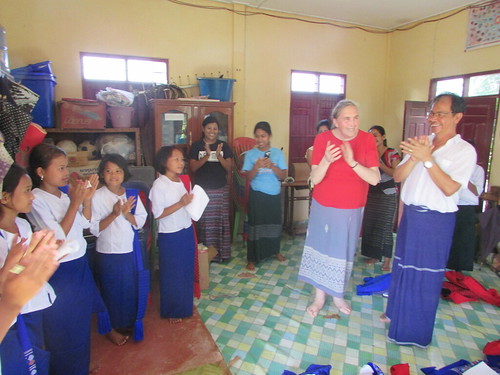
Distribution at Mot Ka Nin, 2018: Smiles all round!
We then retraced our route to La Mine where we took ‘sweet tea’ and dinner in one of the many tea shops near the large monastery.
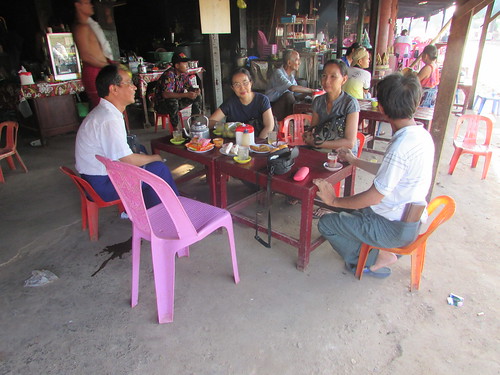
‘Sweet tea’ and dinner in one of the many tea shops near La Mine Monastery.
After our meal, my friends paid their respects to the Buddha Image in the temple. The simple piety of the Myanmar people I find very moving.
In the town, we stopped to purchase fresh Durian fruit. This is never a simple task in Myanmar and invariably there is good-natured haggling before the deal is struck.
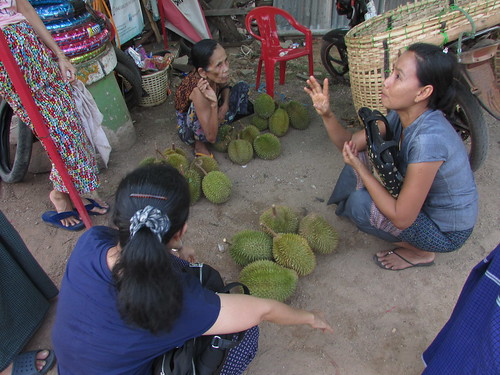
Purchasing Durian Fruit in La Mine
Then, it was back to Ko Dut Drop In Centre for the night. At present, electric power at the Drop In Centre is supplied by one of two elderly portable electric generators. The heat had tired me out and I was asleep before our generator was turned off.
Related posts on this website
This is one of a series of posts describing my 13th visit to Myanmar. The post Travelling again is the first post in the series.
Clicking on the 'Next report' link displays the post describing the next events. In this way, you may read about the trip in sequence.
Next report.
Alternately, clicking on the 'All my Burma-2018 reports' link displays all the posts on this trip in reverse date-of-posting order.
All my Burma-2018 reports.
My pictures
Distribution at Ko Dut Monastery, 2018
Distribution at La Mine Drop In Centre
Distribution at Mot Ka Nin
La Mine and Ko Dut D.I.C.
All my pictures on this trip to Myanmar can be found at Burma 2018.
[Pictures linked 10-May-2018, Pictures inserted 26-May-2018]
Recovering Thursday/Friday 19th/20th April 2018
I must be getting old. The journey from England seemed to have taken its toll and I spent most of Thursday just lying on my bed. It's hot in Yangon at this time of year - the internet said 37 degrees Celsius (that's 99 degrees Farenheit). I've always tried to acclimatise to local conditions and persevered with the fan in my room for some hours before giving in and resorting to the air conditioning set to a moderate 25 degrees Celsius. It was early evening before I emerged, rather befuddled. Because of the heat, the number of Western tourists dwindles at this time of year. So why am I here now?
My host, Doctor Hla Tun, is Ship's Doctor on the luxurious Belmond 'Road to Mandalay' river cruise ship.
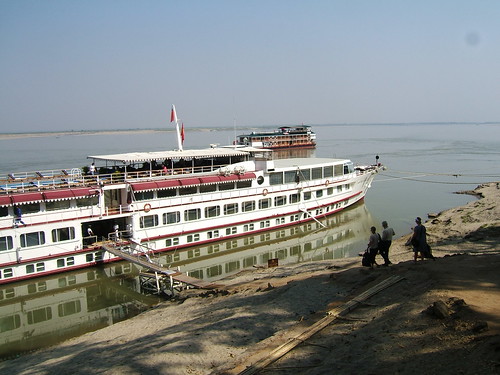
'Road to Mandalay' moored at Bagan during my very first trip to Myanmar in 2008. The vessel in the background is the rather less luxurious 'Government Ferry'.
When the ship is operating, his on-ship duties confine his charitable work to the Mandalay-Bagan area and the Bagan Medical Clinic. But, during the 'low tourist season', the ship stops operating allowing the Doctor to attend to charitable initiatives in other parts of Myanmar. For some years, the Orphans and Vulnerable Children (OVC) project in Mon State has been supported by the Doctor and, by travelling to Myanmar now, I'm able to see for myself what donations make possible.
Of course, having slept most of the day inevitably sleep eluded me for much of the night, particularly since I'd developed an itchy heat rash. I'm afraid I was largely inactive on Friday, too, gathering my strength for our trip south by overnight coach Friday evening.
During the day, the Doctor was arranging to parcel the items which would travel on the coach with us for distribution to children in Mon State. With distributions planned to over a thousand children at various locations around Mon State, it's a major logistical exercise to ensure that the required items are available.
Related posts on this website
This is one of a series of posts describing my 13th visit to Myanmar. The post Travelling again is the first post in the series.
Clicking on the 'Next report' link displays the post describing the next events. In this way, you may read about the trip in sequence.
Next report
Alternately, clicking on the 'All my Burma-2018 reports' link displays all the posts on this trip in reverse date-of-posting order.
All my Burma-2018 reports
My pictures
You can find all the pictures taken on this trip at Burma 2018.
In the post 'Learn to be a Driver' Courses at Birmingham Railway Museum I described the talks given to driving trainees about locomotive engineering at Tyseley.
The article below on Locomotive Boilers is based on some of my notes from that period.
So you want to drive a steam locomotive?
It takes some time to really learn the job. In the pre-war days of the 'Big Four' (LMS, GWR, LNER, SR), you could be working on the footplate for 20 years or more before you graduated to become a driver. In that time, you were expected to have picked up a lot of knowledge, a lot of experience. The engine driver is like the captain of a ship: on the footplate, he is in charge. Whatever happens, it's up to the driver to decide what to do. The confidence to take the right actions in an emergency depends upon familiarity with the construction and working of engines. Well, let's make a start and keep it fairly simple.
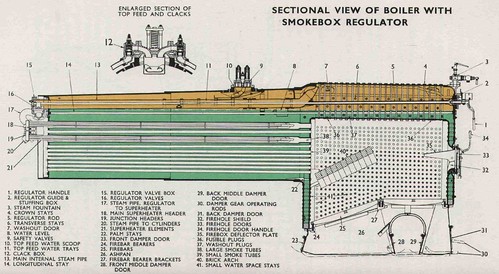
Great Western large taper boiler (less smokebox)
Click for larger version.
All the great locomotive designers have understood that the key to a successful engine design is its ability to boil water. If you can't make steam in the first place, everything else is a waste of time. Here, in the yard at Tyseley, we've a number of locomotives under restoration and this gives us the chance to look at a boiler which has been lifted out of the frames. This is a Great Western design boiler, taken off an 8-coupled freight locomotive, but fairly similar to the boilers used on all larger GWR engines (see diagram above). The principles are the same as almost all steam locomotives in the world - the classic 'Stephensonian' boiler going right back to the Rocket, built in 1829! Looking at the boiler, supported on wooden packing on the ground, it's apparent that the boiler unit is, in fact, three parts joined together. In the middle is the boiler itself, recognisable by its fairly cylindrical shape. This is chosen to give it sufficient strength to contain the high-pressure steam which will collect above the surface of the boiling water which will fill the boiler when it's in use. In a lot of locomotives the boiler is a proper cylinder and we call it a 'parallel' boiler. But this one is a bit more complicated, as it is coned slightly towards the front of the engine and is called a 'taper' boiler. The main reason for this tapering is to improve the internal convection currents in the water as it is boiled. The back end of the boiler is joined to a complex structure called the firebox, bristling with riveted stay heads. This is where the fuel is burnt to produce the heat energy which boils the water. The front end of the boiler is joined to a simpler, cylindrical tube called the smokebox which carries the chimney.
Let's have a closer look at the firebox. That's where the coal goes, so that's where it all starts. The firebox is rectangular in plan and towers above us in a sort of inverted-U section, open at the bottom. The front end of the firebox is joined onto the boiler barrel and the back end is solid, apart from a number of small piercings for mounting various boiler fittings and a circular hole about 18-inches diameter, called the firehole. That's where the coal goes, so the cab, sits immediately behind the firebox with the footplate, where the driver and fireman work, built up to a little below the firehole. This arrangement is supposed to make it easy for the fireman to swing round and collect coal from the bunker or tender containing coal behind the cab, then deftly deliver each shovelful through the firehole and onto the right spot on the fire. As you'll see when we get on the road, it's not always that easy.
This boiler is under restoration, so many of the stays are missing. Instead, you can see a tapped hole in the steel outer firebox which will receive the screwed stay which is riveted over after fitting to make it completely steam tight. Looking through the hole in the outer firebox, you can see an inner firebox wall about 3-inches away, with a corresponding threaded hole. The stays, thousands of them on a large boiler, suspend the inner firebox from the outer firebox making a strong, rigid structure. Because this boiler has been lifted up on sleepers, we can actually duck under the bottom of the firebox and stand up inside the firebox. Now the structure is a little clearer. We're standing in an upside-down box, open at the bottom. This inner firebox is made of copper, so that it can quickly conduct the heat from the fire, which would be where we're standing, through to the water on the other side, trapped in the space between inner and outer fireboxes. Around the base of the firebox, inner and outer fireboxes are riveted together through a substantial foundation ring. Brackets projecting inside the firebox near the foundation ring are used to carry a series of cast iron firebars which, when work on the stays is complete, will sit across the bottom to support the burning fuel. The firebars have ends wider than the middle so that narrow air spaces are left between adjacent firebars allowing combustion air to be drawn up through the burning fuel.
Perhaps we should briefly discuss the chemistry of the combustion of coal. Coal is a naturally-occurring substance extracted from the ground comprising mainly carbon and carbon in association with hydrogen. Analysis varies widely according to where the coal is found. Iron, sulphur and ash-forming impurities are normally present. The importance of coal is that, if warmed to a few hundred degrees Farenheit, it emits vapours which will burn in the presence of air. That means, principally, that the hydrogen in the coal combines with oxygen in the air to form water vapour and the carbon in the coal combines with oxygen in the air to form the colourless, odourless gas called carbon dioxide. These are the same combustion products given off by cars burning petrol or diesel which, like coal, are also hydrocarbons but in liquid form more readily burnt than coal. In all cases, the chemical reactions in which oxygen combines with hydrogen and carbon in the fuel gives off a lot of heat (the reactions are said to be 'exothermic') and this is what we're after - heat energy which can be converted into mechanical energy to make the engine go.
Coal doesn't burn that easily. We have to raise its temperature to about 800 degrees Farenheit (400 degrees Celsius) before it starts to emit a burnable gas. This is the oily, tarry volatile part of the coal, made up of complex hydrocarbons which give off heat when they are oxidised by burning in sufficient air. This air supply is critical. The oxygen needed for burning is only around 1/5 of air by volume. Air is mainly nitrogen, which is an inert gas playing no active part in our combustion. For the volatile hydrocarbons to burn away properly, we have to make sure that there's sufficient air to provide all the needed oxygen. A lot of the details of a locomotive boiler are concerned with arranging and controlling this air supply. If we don't provide enough oxygen, the hydrocarbons drift away as a yellowish gas and the heat we could have produced by burning them is lost.
When the volatiles have burned away, what remains is principally carbon, as coke. This will burn away fairly slowly. If sufficient combustion air is provided, then the carbon oxidises to carbon dioxide, giving off considerable heat in the process. This reaction takes place at a considerably higher temperature - around 2800 degrees Farenheit (about 1500 degrees Celsius). If the air supply is restricted, the carbon oxidises to carbon monoxide. This reaction takes place at a much lower temperature and liberates far less heat. Again, we lose energy.
So a conscientious fireman will understand the reactions taking place in the firebox and will regulate matters so that the coal is burnt efficiently, releasing the maximum amount of energy. That way, he will use less coal and use less physical energy himself.
As each individual lump of coal emits burnable vapours, it becomes smaller and smaller and sinks down towards the firebars, as fresh coal is added on the surface. Eventually, all the carbon is gone and what remains is the incombustible ash. If you're lucky, this will fall through the air spaces between the firebars and be collected in the ashpan suspended underneath the firebox. But many coals contain a certain amount of iron, often in the form of iron pyrite (Fool's Gold), comprising iron in association with sulphur. The sulphur in the iron pyrite is released as a gas, sulphur dioxide, discussed below, whilst the iron combines with the ash content to form a solid slag or clinker. This can spread out across the firebars as a solid sheet, blocking the air spaces and reducing the usable area of the firegrate. This problem is called 'clinkering' and may announce itself by the boiler suddenly stopping steaming as the grate chokes up. So a fireman will pay careful attention to the fire, firstly to minimise the production of clinker as much as possible and, where unavoidable, to break up the clinker before the pieces become too large.
The origin of the coal will determine its chemical analysis and thus its clinker-forming characteristics. Not all coals are suitable for locomotives. Coals with a high sulphur content are problematic. As with iron pyrite, the sulphur combines with oxygen in the combustion air to give sulphur dioxide which then further reacts with the water vapour produced by the combustion of the volatile hydrocarbons to give sulphuric acid - 'acid rain'. Not only is this environmentally unfriendly, but the smoke tubes in the boiler leading the gases away from the firebox to the chimney are damaged by the acid.
Unless very carefully controlled, burning coal can be a very dirty, smoky business. The volatile gases given off, if incompletely burned, give a dark grey exhaust at the chimney. In addition, small particles of coal tend to get carried away before they are burned, appearing as black smoke at the chimney.
The original Act of Parliament allowing steam locomotives to be used on railways (Railway Act 7th George IV) was very concerned about the tendency to produce black smoke and the legislation said that locomotives must "consume their own smoke". In 1829, when the design of the Stephensonian boiler evolved, the only way to achieve this with the readily-available fuels was by using coke, not coal to power the engine. As discussed earlier, coke is what you get when you heat coal and drive off the volatile hydrocarbons. This has to be done with a limited supply of air, allowing the hydrocarbons to be released, but preventing the second stage of burning as the carbon burns. Originally, this was done by digging a pit in the ground, filling it with coal, setting fire to it and covering the coal to restrict the available air. Although coke burning was effective as a means of preventing smoke, the separate production process was inconvenient and a number of locomotive engineers experimented to find a way of burning coal directly in the firebox. The answer, when it came, was relatively straightforward. Matthew William Kirtley of the North Midland Railway (later the Midland Railway) realised that gases and fine particles emitted from the burning fuel in a locomotive firebox were being drawn away from the hot area immediately above the firebed, where conditions were favourable to complete combustion, too quickly for all the reactions to take place. Some of the combustion air was being drawn straight through the firebed and through the smoke tubes to the chimney, without its oxygen being used up in helping to completely burn the fuel. What was needed was some means of promoting more intimate mixing of the combustion air with the hydrocarbon gases and small coal particles in the space above the burning fuel. The answer was an inclined arch set across the width of the firebox, made from heat-resisting refractory bricks. This deliberate obstruction to gases leaving the firebox via the smoke tubes causes the gases to be reflected back towards the fire and swirl around above the firebed, delaying their exit and giving an opportunity for all the oxygen in the air to be used up in complete combustion. When the engine is worked hard, the brick arch itself becomes very hot and this, in turn, helps to keep the gases at the high temperature needed for complete combustion.
There are two sources of combustion air to a locomotive fire. The first has been discussed: air drawn from under the locomotive, through the ashpan , through the slots in the firegrate and through the burning mass of fuel. This is called primary air, or 'bottom' air. But the firehole provides not only the means for getting coal into the firebox, but also a means of allowing further air into the firebox. This is called secondary, or 'top' air. Secondary air is introduced above the burning fuel, providing additional air which mixes with the gases being given off by the coal, supplying additional oxygen to allow complete, efficient combustion of the gases. This secondary source is used as required, the fireman judging when to run with the firedoors closed and when to run with the firedoors open or partially open. The fire will be hottest running on primary air alone, but unless there is adequate draught on the fire to pull sufficient air through the firebed, there is the chance of incomplete combustion or the production of excessive smoke. Opening the firedoors allows in additional air but since secondary air, unlike primary air, is not pre-heated by passing through the firebed, the effect will be to slightly cool the fire.
The main function of the ashpan, hung underneath the firebox, is to collect the ash and cinders produced by the burning coal as they drop through the spaces in the firegrate. A traditional ashpan is provided with a solid bottom and solid sides made from sheet steel but one or both ends are arranged with hinging doors called dampers. These can be manually opened and closed by a mechanical linkage to the footplate, allowing the fireman to manually regulate the amount of primary air. Gravity is normally arranged to keep the dampers closed and there is frequently a series of notches in the damper control lever allowing the fireman to latch the damper door at different openings.
During disposal of the locomotive on shed, all the dampers are opened wide allowing the disposal staff to stand in a pit and rake out all the ash. This is essential as, once the ashpan is full of ash, it prevents combustion air from passing through the ashpan to reach the fire. There are many different layouts of ashpans, dampers and damper control linkages. On small locomotives, there may only be a back damper with the front of the ashpan solid. Two dampers are most common, one front, one back (sometimes termed 'fore' and 'hind'). In some locomotive designs, the trailing axle gets in the way of the ashpan, which may have to hump up to clear the axle. This may require additional damper doors to ensure that all the ash can be cleared. In large GWR locomotives like 'Castles' or 'Kings', two completely separate ashpans are provided, one in front of the trailing axle and one behind. These ashpans are provided with a total of four dampers, two front and two back. 'Merchant Navy' and 'West Country' Pacifics have a screw arrangement operated from a handwheel in the cab to set the position of the dampers.
Clinker is the enemy of the fireman. The various overgrown pokers carried on engines, called fireirons, are provided to let the fireman poke about in the fire, to break up clinker and assist ash in dropping through the firebars into the ashpan. There's usually a selection to reach different parts of the firebox. In a narrow firebox of a large engine, the fireiron is about twelve feet long, so it's no easy task to wrestle it down from the tender, rake it through the mass of fire and then, with the working end now red hot, lift it back onto the tender. 'Cleaning' the fire is best done whilst stationary but, if the fireman is caught unawares by an engine that won't steam, the process has to be done on the road. But with good coal fired intelligently onto a fire that was clean to start with, an engine can steam all day without attention from fireirons.
Well, there's lots more to say about boilers but that'll do for now.
Events of Thursday 19th April 2018
The flight from Doha to Yangon left from the 'E' group of gates which, because they are at the end of a long 'spine', are served by their own automatic 'railway', rubber-tyred and cable-hauled. Our gate was on the ground floor and we were led to a waiting, modern, articulated transfer bus indicating that the aircraft was at a remote stand.
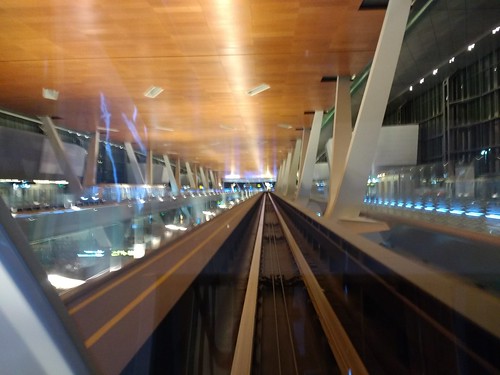
Rubber-tyred, cable-hauled automatic 'railway' serving 'E' group of gates at Doha Airport 18th April 2018
The Business Class section of the waiting A319 had just eight modern seating units but I discovered that I was the only Business Class passenger so I was thoroughly spoiled by the friendly cabin crew. I watched 'Paddington 2' (about the bear, not the raiway station) whilst they served dinner then decided to sleep on the almost-flat bed. After a few hours sleep, I watched a couple of episodes of the 'sit-com' 'WIA' about the BBC whilst taking a continental breakfast. The flight duration was five and a bit hours and, although our published arrival was 06:00 we actually touched-down at five o'clock. To my surprise, by 05:15 my arrival formalities had been completed and I was reunited with my checked bag.
Doctor Hla Tun and his wife met me, as arranged, and we drove to the Doctor's home where a breakfast (fried egg, oatmeal, Coca-Cola which had become the 'default menu' on previous trips to suit my rather intolerant tastes) was immediately placed in front of me. The Burmese people are some of the most hospitable in the world. The Doctor prescribed rest after my long journey and, for once, I was disinclined to argue. I did, however, set-up my Dell laptop to allow me to work on the computer occasionally.
Related posts on this website
This is one of a series of posts describing my 13th visit to Myanmar. The post Travelling again is the first post in the series.
Clicking on the 'Next report' link displays the post describing the next events. In this way, you may read about the trip in sequence.
Next report
Alternately, clicking on the 'All my Burma-2018 reports' link displays all the posts on this trip in reverse date-of-posting order.
All my Burma-2018 reports.
My pictures
Doha Airport, Qatar.
(Pictures taken on this and previous transits/visits to Qatar).
Yangon Airport.
(Pictures taken on this and previous visits to Yangon).
[Pictures linked 25-May-2018]
The Old Locomotive Committee (OLCO) is the 'Supporters Club' for the 1838 locomotive 'Lion' and 'Lion' models. The full-size 'Lion' now has pride of place in the Great Port Gallery of the Museum of Liverpool on Liverpool's Waterfront.
Events of Saturday, 14th April 2018
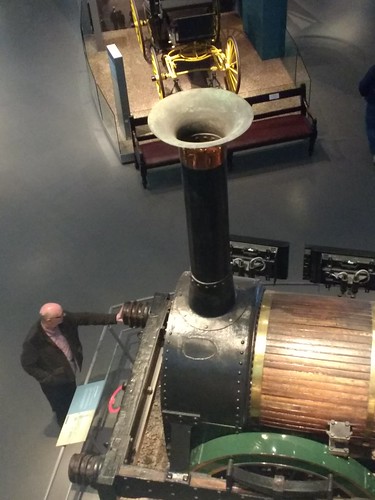
'Lion' in the 'Great Port' Gallery at the Museum of Liverpool.
This overhead view reveals the need for a bit of dusting.
Special Talk
At 12 noon, prior to the A.G.M., the Chairman introduced a special talk about ‘Lion’ entitled "The Lion's tale" which was given by historian and author Anthony Dawson. This entertaining and informative talk described the design and build of the locomotive, her various patents and gave a glimpse of engine driving life in the 1830s.
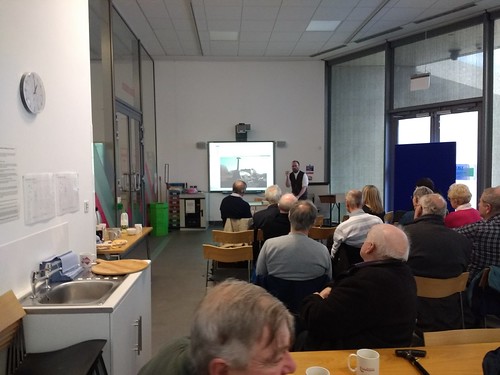
OLCO AGM 2018: Anthony Dawson giving his talk "The Lion's tale".
The A.G.M.
The 33rd Annual General Meeting of OLCO was opened by the Chairman of OLCO, John Brandrick in the Museum's Education Room 2 at 1.30 p.m. The meeting was very well attended this year and, in addition to electing a committee for the next year, there was much lively discussion about 'Lion' matters, both prototype and model. Members of the society will receive formal minutes of the proceedings. The Museum's Curator of Land Transport & Industry, Sharon Brown, was present and made OLCO Members welcome. The society is grateful to Sharon for providing the venue.
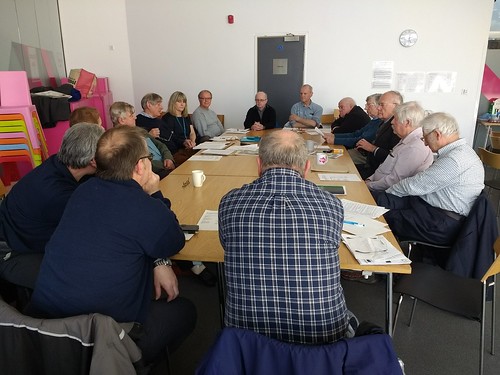
OLCO AGM 2018: The Chairman addresses the meeting.
The A.G.M. had been held at the Museum each year since 'Lion' was installed in the Great Port Gallery. There are brief reports on some earlier A.G.M. at the Museum in this blog:-
2012
2013
2014
2015
The Old Locomotive has its own website here.
Other posts about OLCO on this website
All my posts about OLCO and 'Lion' are here.
My OLCO Pictures
There's a small album of pictures taken on the day here.
All my pictures showing 'Lion' and OLCO events are in the collection The Old Locomotive Committee and Lionsmeet.
Events of Wednesday 18th April 2018
I'm writing this in the spacious Qatar Airways Business Lounge in Doha. I'm on my way to Burma (now called Myanmar) at the start of my 13th visit to Burma since my first tentative exploration in 2008.

Business Lounge, Hamad International Airport, Doha
This will be a mixture of visiting friends, sightseeing and finding out more about the charitable initiatives run by Doctor Hla Tun.
I left Manchester this morning at 08:20 on Qatar Airways Flight QR22, enjoying the excellent service provided on the comfortable Boeing 787-8. It's six p.m. as I write this and I should continue to Yangon at 19:55 on an Airbus A319, arriving six a.m. on Thursday morning.
Related posts on this website
This is one of a series of posts describing my 13th visit to Myanmar. This post is the first post in the series.
Clicking on the 'Next report' link displays the post describing the next events. In this way, you may read about the trip in sequence.
Next report.
Alternately, clicking on the 'All my Burma-2018 reports' link displays all the posts on this trip in reverse date-of-posting order.
All my Burma-2018 reports.
My pictures
Doha Airport, Qatar.
(Pictures taken on this and previous transits/visits to Qatar).
[Pictures linked 24-May-2018]







 Distribution at Hlaing D.I.C. - a motor cycle taxi removes the 'stage'
Distribution at Hlaing D.I.C. - a motor cycle taxi removes the 'stage'





















































